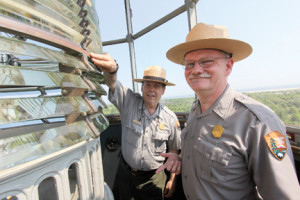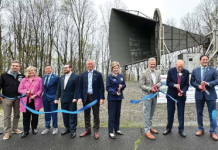By John Burton
SANDY HOOK – After climbing the 95 steps to the top of 250-year-old Fort Hancock lighthouse, there’s a view that money can’t buy.
“It is remarkable,” said John Harlan Warren, a National Park Service (NPS) external affairs officer.
He and National Park Service Ranger Tom Hoffman, the fort historian, took in the 360-degree view from atop of the 73-foot lighthouse (103 feet when factoring in the top of the lightning rod, Hoffman pointed out), scanning the site of the former U.S. Army military installation at the northern tip of Gateway National Recreation Area at Sandy Hook. The view takes in the beach and Atlantic Ocean to the east, Sandy Hook Bay to the west and New York City in the not-too-distant north.
“It is our past and our future,” Warren said.
The lighthouse has a remarkable history and the park service is sharing it as it prepares to celebrate it 250th anniversary.
The lighthouse beacon was first turned on June 11, 1764, making it the oldest continually operating and still standing lighthouse of the 11 first constructed in the 13 original colonies, according to Warren.
 In preparation for the anniversary, the park service has had the structure power washed, making the white tower – repainted in 2000 – gleam in the sun. In honor of the anniversary, as well, the Sandy Hook Foundation, a private not-for-profit fundraising organization, has paid to have the exterior of the former lighthouse keeper’s house repainted to spruce it up for the occasion, Warren said.
In preparation for the anniversary, the park service has had the structure power washed, making the white tower – repainted in 2000 – gleam in the sun. In honor of the anniversary, as well, the Sandy Hook Foundation, a private not-for-profit fundraising organization, has paid to have the exterior of the former lighthouse keeper’s house repainted to spruce it up for the occasion, Warren said.
The park service will be having a series of free, family friendly activities to mark the anniversary from 11 a.m. to 4 p.m. Saturday June 14. There will be historic reenactments, musket drills, cannon demonstrations, games and lectures on the lighthouse and fort’s history, Warren said.
The lighthouse sits back a fair distance from the shoreline these days, nestled in the cluster of structures that had been part of the fort. But, that wasn’t always the case.
“When this was new in 1774, you would have had a shore view” with the lighthouse sitting right on the tip of Sandy Hook, Hoffman said. During the past two-and-a-half centuries the shoreline has been extended by about a mile – from the tidal shift of sand north and “the tip growing away from the lighthouse.”
Construction of the lighthouse was begun 1762 and was initially erected with stone, probably rough granite, Hoffman said. It measured about 7-feet thick at its base.
The construction, in a large part, accounts for its longevity. Many other lighthouses of the time, including one built in Boston even earlier, were constructed of wood, making them vulnerable to fire and weather.
“You need a strong structure to deal with Mother Nature,” Hoffman said.
To pay for its operation and maintenance, the Colony of New York imposed a tonnage tax of three pence per ton on cargo ships sailing into New York Harbor. The tax proceeds were used for the lighthouse’s upkeep and to pay the lighthouse keeper, according to Hoffman.
By 1863, Sandy Hook’s lighthouse was reinforced with bricks, thickening the base of it to about 10 feet. At that point, metal stairs were installed, replacing the wooden ones, Hoffman said.
During that renovation, workers found impressions and damage caused by cannon fire, shot by the Continental Army, firing on what had become a British outpost. By 1776, the Sandy Hook peninsula had fallen under British control. They fought to retain the area because of its proximity to the New York Harbor and to protect British ships traveling across the Atlantic, Warren said.
The lighthouse was one of three lighthouses – and the tallest –on the peninsula. The two smaller ones, called beacons, stood about 35-feet-tall and were positioned on the western and northern ends of Sandy Hook. They were dismantled in 1917 as the United States entered World War I, Hoffman said.
For many years the lighthouse used whale oil to light the lantern in its lens house, or lanthorn, with the keeper responsible for lugging the oil up the 95 stairs. By the 1850s and the emergence of industrialization and factories, which created a large demand for whale oil that drove the price up, the lanterns were changed to use the more accessible – and cheaper – kerosene, Hoffman said.
The lighthouse was electrified in 1925 and remains constantly lit with its Fresnel lens that can be seen as far out to sea as 19 miles on a clear night.
The U.S. Coast Guard officially turned the lighthouse over to the park service in the 1970s when the fort was decommissioned and it became part of the national park system. But, the Coast Guard continues to maintain and operate it for nautical safety, the park service representatives said.
The Coast Guard took responsibility for the lighthouse in 1939 when President Franklin D. Roosevelt disbanded the U.S. Lighthouse Service, according to Hoffman.
The lighthouse continues to serve a real purpose and is more than simply an interesting and quaint historical artifact, they stressed.
“Even with the modern technology,” GPS equipment and the rest, “the helmsmen with the big oil tankers and big cargo ships still want to see something,” Hoffman said.
“Lighthouses keep people safe and this has kept people safe for two centuries,” Warren added. “Now it is the job of the National Park Service to keep this safe.”
About 25,000 visitors a year tour the lighthouse of the 2 million who annually visit Sandy Hook.
The most recent iteration of the keeper’s house dates back to 1883. It has three stories and originally contained eight bedrooms, kitchen, parlor and dining room to accommodate the keepers and what may have been a their fairly large families.
Today, it serves as the fort’s visitor center, containing a small museum with multimedia displays on the site’s history, a gift shop and offices.
Both spots are open to the public, with the park service conducting daily lighthouse tours every half hour of the lighthouse from 1 to 4:30 p.m. Visitors are permitted to climb the stairs and see the priceless views from the lighthouse.














